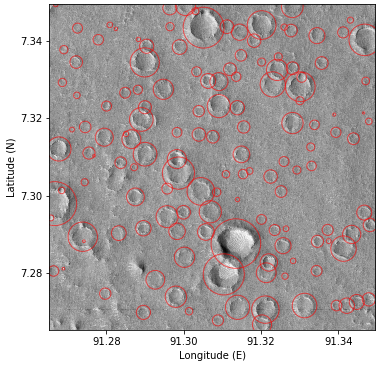Towards a Statistical Analysis of Secondary Cratering Rates over Isidis Planitia, Mars
- 1UCL, Mullard Space Science Laboratory, Space and Climate Physics, Dorking, United Kingdom of Great Britain and Northern Ireland (ucasafr@ucl.ac.uk)
- 2Hummingbird Technologies Ltd., 51 Hoxton Square, Hackney, London, N1 6PB, UK
A key uncertainty in our understanding of crater populations is the number and spatial distribution of secondary craters, which can contaminate and artificially increase the number of observed impacts, especially at sub-km diameter ranges [1]. Constraints to this unknown have been derived from two branches of work, or in combination. One is physical modelling, in which simulations and our understanding of impact process dynamics provide estimates of the size, number and trajectory of secondary impactors produced by the primary [2]. The other uses visuospatial studies, wherein experts attempt to identify and count craters thought to be secondaries, and use these to produce bounds on the number of secondaries produced by a specific primary crater [3], [4]. In this work, we propose a third approach which we hope to use to further quantify the extent of the secondary crater population on Mars, in a way that is as independent as possible of previous estimates.
We propose to use spatial statistics and stochastic modelling across a large region of Mars in order to decouple the primary and secondary populations, using some simple assumptions about the nature of the two overlapping distributions. First, the primary distribution is---although locally random---constant over the region of interest. Second, the secondary crater population can be modelled as a 2-dimensional normal distribution emanating from each primary crater, with a standard deviation much smaller than the dimensions of the region of interest. With these assumptions, we can then model the total distribution with only a few parameters: The primary distribution, the number of secondaries produced by a primary of a given size, and the standard deviation of the secondary craters' distance from their parent.
Given the importance of a uniform primary population for our method to work, we have selected Isidis Planitia as our study site. This large, flat plain is remarkable in its geological consistency, and is thought to be the basin of a large impact in the Noachian period. The surface we see today, excluding overlaid impact sites, is a single geological unit, with an estimated age of 2.8 Gy [5]. In total, it covers roughly 6 million km2.
The huge quantity of craters required for a method such as this to be successful has necessitated the use of automated detection. We have refined the Mask R-CNN architecture [6]---widely used for instance segmentation tasks---in order to detect craters. Trained on a variety of different Martian crater datasets, we have used this model to produce the most numerous crater survey to date over the Isidis Planitia region of Mars (see Figure 1). With these data, we will attempt to use statistical analysis to empirically estimate the number of expected secondaries, and their spatial distribution, for a primary of a given size.
We hope that our results will further constrain the processes governing the production of secondary craters. In the future, this method could be straightforwardly applied to other regions of Mars, as well as the Moon, to see how the atmosphere and a surface's geology affects secondary craters.

Figure 1: Automatically detected craters over Isidis Planitia, using CTX imagery. Diameters are enlarged so that crater candidates can be seen more clearly.
[1] Williams, J.P., van der Bogert, C.H., Pathare, A.V., Michael, G.G., Kirchoff, M.R. and Hiesinger, H., 2018. Dating very young planetary surfaces from crater statistics: A review of issues and challenges. Meteoritics & Planetary Science, 53(4), pp.554-582.
[2] Watters, W.A., Hundal, C.B., Radford, A., Collins, G.S. and Tornabene, L.L., 2017. Dependence of secondary crater characteristics on downrange distance: High‐resolution morphometry and simulations. Journal of Geophysical Research: Planets, 122(8), pp.1773-1800.
[3] McEwen, A.S., Preblich, B.S., Turtle, E.P., Artemieva, N.A., Golombek, M.P., Hurst, M., Kirk, R.L., Burr, D.M. and Christensen, P.R., 2005. The rayed crater Zunil and interpretations of small impact craters on Mars. Icarus, 176(2), pp.351-381.
[4] Robbins, S.J. and Hynek, B.M., 2011. Secondary crater fields from 24 large primary craters on Mars: Insights into nearby secondary crater production. Journal of Geophysical Research: Planets, 116(E10).
[5] Ivanov, M.A., Hiesinger, H., Erkeling, G., Hielscher, F.J. and Reiss, D., 2012. Major episodes of geologic history of Isidis Planitia on Mars. Icarus, 218(1), pp.24-46.
[6] He, K., Gkioxari, G., Dollár, P. and Girshick, R., 2017. Mask r-cnn. In Proceedings of the IEEE international conference on computer vision (pp. 2961-2969).
How to cite: Francis, A., Crawford Clarke, R., Sidiropoulos, P., and Muller, J.-P.: Towards a Statistical Analysis of Secondary Cratering Rates over Isidis Planitia, Mars, Europlanet Science Congress 2020, online, 21 September–9 Oct 2020, EPSC2020-717, https://doi.org/10.5194/epsc2020-717, 2020

